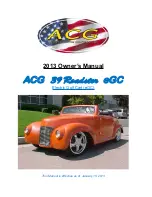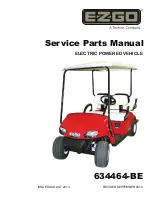
GB-37
RANSOMES DIABLINE
SAFETY AND OPERATORS MANUAL
B.1.7 Simple Steps For Longer Battery Life
Copyright Trojan Inc. used with permission
Equipment:
Trojan recommends the following equipment for
use
in battery care and maintenance:
• Wrench
• Post Cleaner
• Distilled Water • Baking Soda
• Voltmeter
• Petroleum Jelly
• Hydrometer
• Goggles & Gloves
CAUTION: Always wear protective clothing,
gloves, and goggles when handling
Proper Torque Values for Connection Hardware
Flooded
Automotive:
50-70 in-lbs
Side:
70-90 in-lbs
Wingnut: 95-105 in-lbs
LPT:
95-105 in-lbs
LT:
100-120 in-lbs
Gel
Button: 90-110 in-lbs
LT:
100-120 in-lbs
Specifi c Gravity Testing
(Flooded batteries only)
1.
Do not add water prior to testing.
2.
Fill and drain the hydrometer 2-4 times
before drawing a sample from the battery.
3.
Have enough sample electrolyte in the
hydrometer to completely support the
fl oat.
4.
Take a reading, record it and return the
electrolyte to the cell.
5.
Check all cells in the battery, repeating
the steps above.
6.
Replace vent caps and wipe off any
electrolyte that might have been spilled.
7.
Correct the readings to 80°F:
•
Add .004 to readings for every 10° above
80°F.
•
Subtract .004 for every 10° below 80°F.
8.
Check the state of charge using the table
on the next page.
The readings should be within the factory
specifi cation of 1.277 +/-.007. If any specifi c gravity
reading registers low, follow these steps:
1.
Check and record voltage level(s).
2.
Put batteries on a complete charge.
3. Take
specifi c gravity readings again.
If any specifi c gravity reading still registers low,
follow these steps:
1.
Check voltage level(s).
2.
Perform equalization charge. (See
Equalizing).
batteries and electrolyte.
Inspection
1.
Examine the outside appearance of the
battery.
•
Look for cracks in the container.
•
The top of the battery, posts and
connections should be free of
dirt, fl uids and corrosion. (If
batteries are dirty, see Cleaning section.)
•
Replace any damaged batteries.
2.
Any fl uids on or around the battery
may indicate that electrolyte is spilling,
leaching or leaking out.
•
Leaking batteries must be replaced.
3.
Check all battery cables and connections.
•
Look closely for loose or damaged parts.
•
Replace any cable that is broken or
frayed.
WARNING: Do not smoke near batteries.
4.
Tighten all wiring connections to the
proper specifi cation (following page.)
Be sure there is good contact with the
terminals.
WARNING: Do not over-tighten terminals.
Over-tightening can result in post breakage,
post melt-down or fi re.




































